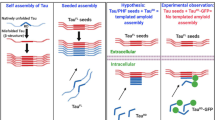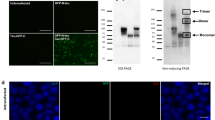Abstract
A primary pathological hallmark of Alzheimer disease brain is the presence of neurofibrillary tangles, which are highly aggregated and insoluble accumulations of the microtubule-associated protein tau. Although it is becoming increasingly apparent that the mature neurofibrillary tangles are not the toxic species, intermediates between soluble tau and the neurofibrillary tangles likely play key roles in the neurodegenerative process. Therefore, it is critically important to be able to quantitatively monitor the process of tau aggregation in living cells in order to understand the evolution of tau from its physiological to its pathological forms. To detect and quantitate the aggregation of tau in cells, we established a split green fluorescent protein (GFP) complementation assay. In this assay, GFP is separated into two spontaneously associating fragments that form the fluorescent fluorophore. The smaller GFP fragment, GFP11, is fused to tau and coexpressed in cells with the larger fragment GFP1–10 leading to the association and reconstitution of the active fluorophore. However, if tau becomes partitioned into aggregates, the GFP11 tag will be less accessible for interactions with GFP1–10 resulting in a decrease in GFP complementation and fluorescence which can be monitored either using fluorescence microscopy or with a fluorescence plate reader. Thus, this assay is a valuable tool for measuring tau aggregation in living cells and evaluating factors that modulate this process.
Access this chapter
Tax calculation will be finalised at checkout
Purchases are for personal use only
Similar content being viewed by others
References
Johnson, G. V., and Bailey, C. D. (2002) Tau, where are we now? J Alzheimers Dis 4, 375–98.
Stoothoff, W. H., and Johnson, G. V. (2005) Tau phosphorylation: physiological and pathological consequences. Biochim Biophys Acta 1739, 280–97.
Ding, H., and Johnson, G. V. (2008) The last tangle of tau. J Alzheimers Dis 14, 441–7.
Grundke-Iqbal, I., Iqbal, K., Quinlan, M., Tung, Y. C., Zaidi, M. S., and Wisniewski, H. M. (1986) Microtubule-associated protein tau. A component of Alzheimer paired helical filaments. J Biol Chem 261, 6084–9.
Kosik, K. S., Joachim, C. L., and Selkoe, D. J. (1986) Microtubule-associated protein tau (tau) is a major antigenic component of paired helical filaments in Alzheimer disease. Proc Natl Acad Sci U S A 83, 4044–8.
Roberson, E. D., Scearce-Levie, K., Palop, J. J., Yan, F., Cheng, I. H., Wu, T., Gerstein, H., Yu, G. Q., and Mucke, L. (2007) Reducing endogenous tau ameliorates amyloid beta-induced deficits in an Alzheimer’s disease mouse model. Science 316, 750–4.
Santacruz, K., Lewis, J., Spires, T., Paulson, J., Kotilinek, L., Ingelsson, M., Guimaraes, A., DeTure, M., Ramsden, M., McGowan, E., Forster, C., Yue, M., Orne, J., Janus, C., Mariash, A., Kuskowski, M., Hyman, B., Hutton, M., and Ashe, K. H. (2005) Tau suppression in a neurodegenerative mouse model improves memory function. Science 309, 476–81.
Chun, W., Waldo, G. S., and Johnson, G. V. (2007) Split GFP complementation assay: a novel approach to quantitatively measure aggregation of tau in situ: effects of GSK3beta activation and caspase 3 cleavage. J Neurochem 103, 2529–39.
Cabantous, S., Terwilliger, T. C., and Waldo, G. S. (2005) Protein tagging and detection with engineered self-assembling fragments of green fluorescent protein. Nat Biotechnol 23, 102–7.
Khlistunova, I., Biernat, J., Wang, Y., Pickhardt, M., von Bergen, M., Gazova, Z., Mandelkow, E., and Mandelkow, E. M. (2006) Inducible expression of Tau repeat domain in cell models of tauopathy: aggregation is toxic to cells but can be reversed by inhibitor drugs. J Biol Chem 281, 1205–14.
Cho, J. H., and Johnson, G. V. (2003) Glycogen synthase kinase 3beta phosphorylates tau at both primed and unprimed sites. Differential impact on microtubule binding. J Biol Chem 278, 187–93.
Meares, G. P., and Jope, R. S. (2007) Resolution of the nuclear localization mechanism of glycogen synthase kinase-3: functional effects in apoptosis. J Biol Chem 282, 16989–7001.
Cho, J. H., and Johnson, G. V. (2004) Glycogen synthase kinase 3 beta induces caspase-cleaved tau aggregation in situ. J Biol Chem 279, 54716–23.
Acknowledgments
This work was supported by NIH grant NS051279 and a grant from the Alzheimer Association.
Author information
Authors and Affiliations
Editor information
Editors and Affiliations
Rights and permissions
Copyright information
© 2010 Humana Press
About this protocol
Cite this protocol
Chun, W., Waldo, G.S., Johnson, G.V.W. (2010). Split GFP Complementation Assay for Quantitative Measurement of Tau Aggregation In Situ. In: Roberson, E. (eds) Alzheimer's Disease and Frontotemporal Dementia. Methods in Molecular Biology, vol 670. Humana Press, Totowa, NJ. https://doi.org/10.1007/978-1-60761-744-0_9
Download citation
DOI: https://doi.org/10.1007/978-1-60761-744-0_9
Published:
Publisher Name: Humana Press, Totowa, NJ
Print ISBN: 978-1-60761-743-3
Online ISBN: 978-1-60761-744-0
eBook Packages: Springer Protocols




